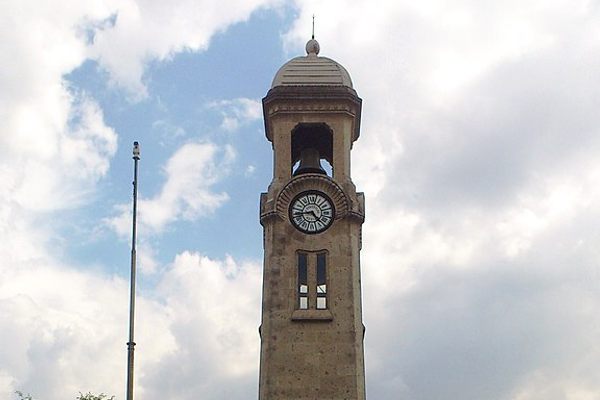AO Edited
Sather Tower
The century-old bell and clock tower at UC Berkeley is the third-tallest in the world, and has fossils.
In 1902 the famous 12th century bell tower known as the campanile in the Palazzo San Marco in Venice, Italy came thundering to the ground. Miraculously no one but a resident cat was hurt in the unexpected catastrophe. The beloved tower was rebuilt “as it was, where it was” in 1912.
UC Berkeley campus architect, John Galen Howard, had visited Venice in the 1890’s, and had the chance to see the San Marco Campanile before its collapse.
Looking strikingly similar to that other famous tower, the Campanile on the campus of UC Berkeley has stood a lynchpin on campus since its cornerstone was laid on March 8, 1914. The Campanile is constructed of 2,800 blocks of Raymond granite quarried from the Sierra Nevada Mountains, over 500 tons of structural steel, and Alaskan marble. The belltower is a gothic architectural form, built in a Neo-Classical way.
Hiding inside its dry climate-steady walls are some fossils belonging to the University of California Museum of Paleontology, many of which come from the La Brea Tar Pits in Los Angeles.
The twelve bells that make up the original carillon were gifts of Jane K. Sather (who also donated the funds to construct the tower, itself) in 1914, but because of war-related delays, they were not installed until 1917. The largest of the bells, weighing in at 4,118 lbs. (the smallest is 329 lbs) is inscribed with the words by UC Berkeley Professor Flag:
We ring, we chime, we toll, Lend ye the silent part Some answer in the heart, Some echo in the soul.
In 1978 an additional thirty-six bells were added after a fund raising mission by the class of 1928, and thirteen more were added in 1983, bringing the total up to sixty-one bells. The carillon is played daily and for special occasions.
The Campanile also does something unique: it moves every day, imperceptibly to the human eye. Well, there is a phenomenon called sun-sway, in which the marble wants to follow the sun (because it absorbs the heat), but the structural frame stays put, causing cracks on the facade of the tower, mainly in the corners. At night, the temperature drops, and the tower returns to its original position.
Know Before You Go
To access the interior of the tower, one has to purchase a ticket. Check the website for varying prices and times of operation.































Follow us on Twitter to get the latest on the world's hidden wonders.
Like us on Facebook to get the latest on the world's hidden wonders.
Follow us on Twitter Like us on Facebook